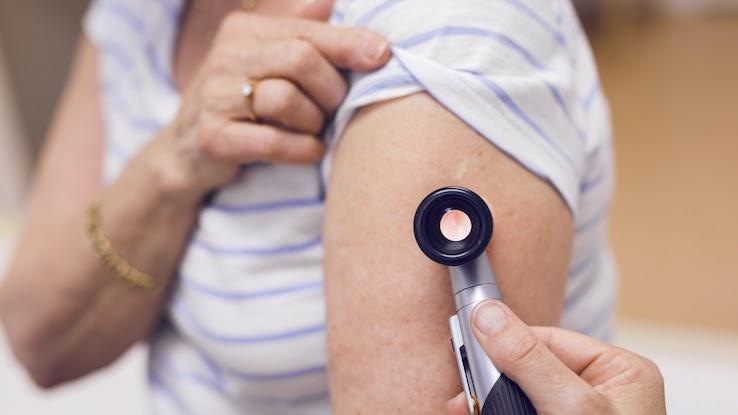I Just Want You to Know Don T You Understand All I Ever Wanted

Melanoma is a blazon of skin cancer that develops in the skin cells (melanocytes) responsible for producing the pigment that gives your skin color (melanin). It's usually caused by ultraviolet (UV) rays from the dominicus or tanning beds. With melanoma, melanocytes that have mutated — meaning they've undergone spontaneous changes that can make them harmful — multiply quickly. This rapid growth forms tumors in the epidermis, your skin'southward acme layer, and the diseased cells can spread to other parts of your body without constructive handling.
Melanoma rates have been ascension over the past few decades. According to the American Cancer Gild, approximately 106,000 new cases are diagnosed each twelvemonth in the United States alone. Melanoma is more prevalent in fair-skinned individuals, and white people are more than than 20 times more likely to develop the disease than Black people. Melanoma is besides more mutual in men. However, other factors can besides influence an individual'southward chance of developing the disease.
Melanoma isn't the most common type of skin cancer; withal, information technology does have the highest expiry and metastasis (meaning it's moved to different areas of your body) rates. There are four main types of melanoma:
- Superficial spreading melanoma is the most common type that accounts for approximately 70% of all cases. It usually begins as a pre-existing mole.
- Nodular melanoma is the 2d most common type that accounts for approximately 15–thirty% of cases. It's a more ambitious form that tends to develop faster.
- Lentigo maligna melanoma accounts for approximately 4–10% of cases. It typically appears as large, flat peel lesions and has a lower risk of spreading.
- Acral lentiginous melanoma accounts for approximately ii–8% of cases in fair-skinned individuals and up to 60% of cases in darker-skinned individuals. Information technology's usually nowadays on the palms, on the feet or under the nail beds, and the lesions are very large in diameter.
Other rarer forms of melanoma include mucosal and ocular melanoma. Mucosal melanoma occurs in the mucosal tissue of body cavities or organs. Common sites include the head and neck and the gastrointestinal and genital regions. Ocular melanoma affects cells in the eyes and can occur in unlike parts of the eye.
Early diagnosis and treatment lead to a high cure charge per unit for melanoma in most cases. If you delay treatment, however, melanoma may spread to other parts of your body, making it difficult to treat successfully. Melanoma is responsible for the most deaths out of all skin cancers.
Symptoms of Melanoma

Melanoma does present with some warning signs. Moles and brown spots on the skin are common and usually beneficial, or harmless. Nonetheless, they can also be symptoms of melanoma. Melanoma tin can develop anywhere on pare, but it most frequently appears on the trunk areas of blanched men and the legs of fair-skinned women. On darker-skinned individuals, melanoma almost commonly develops on the palms, on the soles of the feet or under the nails.
One of the first symptoms of melanoma is the appearance of atypical moles. These moles are often asymmetrical in shape and different in color. Sometimes a malignant, or cancerous, mole volition have a variety of shades of chocolate-brown, black or tan running through it. Cancerous moles may as well have blueish, red or white coloration. Atypical moles often have irregular borders, sometimes appearing notched or scalloped.
The size of a mole is also important. Beneficial moles are commonly smaller, whereas malignant moles are usually larger than a quarter-inch in bore. Another characteristic of a malignant mole is its evolution, meaning it'll modify in advent over time.
An easy way to assist place atypical moles that may exist early on signs of melanoma is by learning the ABCDEFs of skin cancer:
- Disproportion: Check for moles with an asymmetrical or irregular shape (is i half of the mole different from the other?).
- Border: Check for moles with irregular, notched or scalloped borders.
- Colour: Check for moles with colour variations or moles that accept darkened in color.
- Diameter: Check for moles that are larger than a quarter-inch in diameter (nearly the size of a pencil eraser).
- Development: Check moles for changes in appearance over time.
- Feeling: Check for whatever changes in sensation on or around moles (such equally hurting or itchiness).
Causes of and Risk Factors for Melanoma

Generally, exposure to UV radiation from the sun or tanning beds causes melanoma. UV rays damage the DNA of pare cells and cause them to grow irregularly. However, it's of import to note that yous can yet develop melanoma on trunk parts that don't get every bit much directly sunlight, like the palms of your hands and retinas in your eyes.
Various risk factors contribute to your chance of developing melanoma, including genetics. According to the American Cancer Society, nearly x% of individuals who develop melanoma have a family history of the disease. Fair or low-cal peel and numerous irregular moles are other gamble factors that could make you more susceptible to developing this type of skin cancer.
Additionally, there'southward a college risk of melanoma in people who have suppressed immune systems, and the take chances of metastatic melanoma increases when visible primary melanomas haven't been removed. This blazon of cancer becomes more common with age, simply it occurs in younger people equally well.
Melanoma has several stages, which are used to classify the cancer'due south degree of severity. The stage is based on the depth of penetration, the degree of spreading and the thickness of the tumor:
- Stages 0 and I are early stages. In stage 0, the growths are localized and noninvasive. Stage I involves invasion into the dermis level, but the tumors are small.
- Stage Two tumors are larger and may show additional characteristics, such as ulceration, which means at that place'southward a interruption or crack in the skin. This phase is considered an intermediate risk.
- Stage Iii melanoma exhibits ulceration, which indicates significant progression. At this stage the cancer can affect lymph nodes, which can deport cancer to other organs.
- Stage Iv melanoma is the most advanced phase and involves metastasis to the lymph nodes and internal organs, such as the lungs, liver, brain, bones or gastrointestinal tract.
Diagnosing Melanoma

Diagnosing melanoma typically involves a pare biopsy. During this process, your doctor removes a modest tissue sample from the suspicious mole or spot and sends it to a pathologist, who examines the sample and checks it for pare cancer. If the test comes back positive, then your doctor will completely remove the mole and an amount of surrounding tissue.
Additional testing volition be necessary to determine the stage of the melanoma and whether it has spread to your lymph nodes or other parts of your trunk. These tests include a spotter node biopsy, blood tests, molecular analyses and imaging tests, such as:
- Breast X-rays
- Lymphoscintigraphy
- Ultrasound
- Computed tomography (CT) scans
- Magnetic resonance imaging (MRI) scans
- Positron emission tomography (PET) scans
Treatment Options for Melanoma

Melanoma handling often begins with surgically removing the cancerous tissue. Doctors frequently perform this as an outpatient surgery under local anesthesia, meaning you lot don't need to stay overnight in the hospital and won't be unconscious during the procedure (but likewise won't feel information technology happening). An ulcerated tumor will probable also demand a sentinel node biopsy to determine if lymph nodes are involved. Surgeons usually prepare a safety margin around the tumor and remove some healthy-looking tissue. This helps them ensure that all of the cancerous growth is removed.
Treatment options for melanoma that has metastasized beyond the skin include:
- Surgical removal of any affected lymph nodes or other tissues.
- Immunotherapy treatments that help your trunk'south immune organisation fight the cancer.
- Targeted therapy, which identifies and uses drugs that are effective against your specific cancer cells.
- Radiation therapy that uses high-energy beams to kill cancer cells.
- Chemotherapy, which consists of diverse drugs that you take intravenously or orally to kill cancer cells.
Regular followup appointments after treatment are extremely of import because they tin help your doctor detect new or recurrent melanoma as early as possible. Followup care may include Ten-rays, claret tests and imaging tests.
Because a cancer diagnosis tin exist very difficult to process and also life-irresolute in many ways, it's important to learn effective ways to cope with the emotional and physical changes the affliction tin bring upward. Coping methods include learning well-nigh melanoma and the different treatment options then that you're actively involved in your intendance, along with getting the support you need by keeping your relationships with close friends and family strong.
It may also be helpful to notice a advisor or therapist to talk to most how you're feeling. Your dr. may be able to suggest back up groups in your area every bit well, and you tin besides locate these groups and larn additional information through the National Cancer Institute and the American Cancer Club.
Resources Links:
https://www.mdanderson.org/cancer-types/melanoma.html
https://world wide web.cancer.org/cancer/melanoma-skin-cancer.html
https://www.mayoclinic.org/diseases-conditions/melanoma/symptoms-causes/syc-20374884
https://world wide web.mskcc.org/cancer-care/types/melanoma
https://www.cancer.gov/types/skin
I Just Want You to Know Don T You Understand All I Ever Wanted
Source: https://www.symptomfind.com/health/melanoma-condition?utm_content=params%3Ao%3D740013%26ad%3DdirN%26qo%3DserpIndex




Post a Comment for "I Just Want You to Know Don T You Understand All I Ever Wanted"